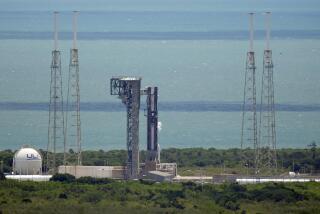NASA Scrubs Plan for Early Retrieval of Satellite
- Share via
KENNEDY SPACE CENTER, Fla. — With a collision no longer a concern, NASA told space shuttle Columbia’s astronauts on Sunday to leave a semiconductor-growing satellite in orbit as planned and forget about retrieving it one day early.
Just hours before, Mission Control had warned the five shuttle crew members they might have to capture the satellite early today instead of on Tuesday.
Sunday night, the 2-ton satellite trailed Columbia by 25 miles. And 25 miles farther back was an ultraviolet telescope. Both were released by the crew last week.
For most of the day, the telescope was traveling faster than expected. Flight controllers fretted over how close the 3.5-ton telescope might be to Columbia if the astronauts were to wait until early Tuesday to retrieve the semiconductor saucer as planned.
But late Sunday, Mission Control determined after extensive number-crunching that the gap between the two satellites would be more than adequate, at least 14 miles, and that an early Monday retrieval was no longer required. Flight directors did, however, push up the rendezvous by three hours, to tonight.
NASA safety rules stipulate that the two satellites be at least 12 1/2 miles apart when the astronauts go in to grab the semiconductor saucer. The shuttle is supposed to make a nine-mile swing around the satellite before capturing it, thus the need for plenty of room. A collision could be disastrous.
The telescope has no propulsion system. The semiconductor satellite, called the Wake Shield, has only a tiny thruster that’s useless for major maneuvers.
University of Houston researchers growing the pure semiconductor film had accepted news of a possibly premature end to their mission.
They’re “not one bit” upset, team spokesman Paul Guse said. “If anything, they’re glowing over the performance so far.”
Unlike previous missions in which it malfunctioned and even flipped, the Wake Shield was working well this time and allowing scientists to accomplish their primary goals.
Five wafers of semiconductor film had been produced in the super-clean wake created behind the Wake Shield, and scientists were working on a sixth.






